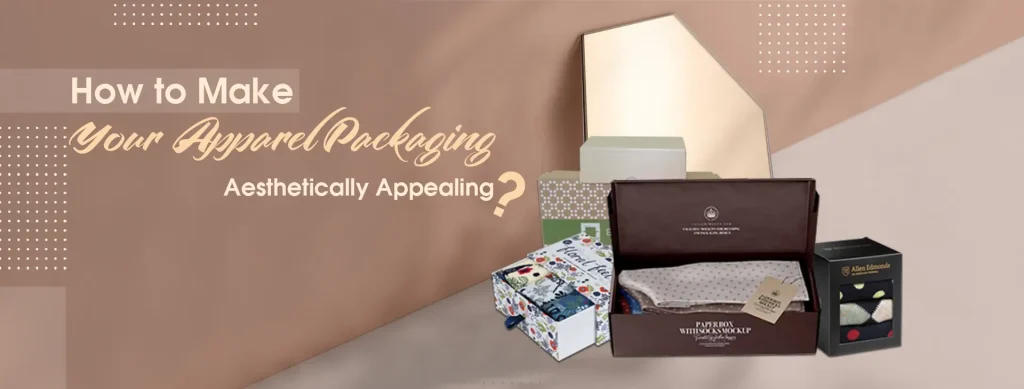The apparel market has become very diverse, and in a competitive market, the brands compete with their rivals for buyers. An eye-catchy packaging design is essential to put the best brand impression on the customer. An appealing apparel packaging will make or break your product. This packaging not only adds beauty to the product but it increases the market value of the product. It also provides a realistic way to preserve a good impression.
A compelling written explanation of the product is beneficial from a marketing point of view. A good packaging designer understands that the font, graphics, colors, and even the content demonstrate to the users why they should purchase it.
An appealing apparel packaging is a brand asset; creating it can be difficult, but it plays a vital role in a brand’s success. Your packaging requirements can vary depending on what you sell and where you sell it.
There is a deep relation between practicality and aesthetics. If you diverge too much in one direction, the other would almost certainly stumble. The key is to strike the right balance between your company’s and brand’s identities.
Tips to Design an Appealing Apparel Packaging
There are several techniques that can help you to design appealing apparel packaging for your brand. Some of those techniques are:
1) Understand the Product Requirements:
Before starting the work on the packaging design, you must determine what you want to do with your product packaging concept. If you’re introducing a new brand or refreshing an existing one, this is the most crucial step in designing. Custom apparel packaging is a way of shipping goods, developing a brand, and executing a marketing campaign all in one.
Every apparel brand has its own set of criteria, which decides what the top targets should be when creating custom packaging. In some outlets, practical considerations, such as how safe the packaging is, best aesthetics, and in others, aesthetics outclasses the practical considerations.
For example, if as an e-commerce retailer, you must plan the packaging with shipping requirements (weight, distance, etc.) in mind. Whatever design you choose, it must allow you to transport your goods safely and efficiently to your customers.
2) Understand the Packaging Needs:
You can’t start designing the packaging until you know what you’re going to use it for! Your product line will decide which packaging features are ideally tailored to your specifications. Boxes are definitely not the right choice if you’re selling small or lightweight items like jewelry or shoes (unless you’re doing bulk orders).
Mailer envelopes are a much more convenient and cost-effective option. You will also provide consumers with a memorable brand experience if you mix these packaging styles with personalized tissue paper for safety.
But if you are selling shirts and other clothes with embroidery work with beads and glass pieces, you need durable packaging because these products are a little sensitive and require special treatment in the packaging process. For these products, corrugated boxes are the best option. These boxes are durable, lightweight, and cheap at the same time.
Before selecting the apparel packaging design, you need to understand the product because the packaging material is selected according to product type and packaging material determines that which design suits the material.
3) Provide Information About Product and Brand:
Customers are more curious about the packaging of the products, and they may prefer your brand because of the aesthetically appealing packaging. You should mention the product details on the packaging.
Otherwise, customers will tend to purchase the other brands. But here comes the question that what you need to mention on the apparel packaging? The answer is very simple, the product size, material, design information, and most importantly, the product color.
The packaging should provide details about the product. The logo should explicitly state what the commodity is and who it is meant for in terms of how it should be appropriate for the location where it is distributed. This is an important concern, particularly in the age of e-commerce. Layers are common in products, including the outer layer, inner layer, and the component itself. Some objects can need more layers than others, depending on what you have.
Products sold online can be packaged more securely, with labeled cushioning materials such as foam, bubble wrap, or tissue paper. The exterior wrapping protects the substance from the elements. The inner wrapping will increase the likelihood of the product delivering safely and undamaged. The final is for the mark.
As a brand, one of the main canvases available to you is the packaging. As a result, personalized packaging necessitates more design requirements than you would expect. Although you want it to be compatible with the other branding materials in terms of elements like color palette and typeface, you still have a lot more leeway. Consider sitting down with a pen and a notepad and telling yourself, “What do I want my packaging to tell customers about my brand?”
This will assist you in focusing on the ingredients that comprise your brand’s tale and will be critical in assisting you in selecting a packaging template that maximizes its potential. Why is this so? Since, no matter how appealing the style is, it must also be functional.
4) Bring Creativity to Packaging Design:
With an interesting color range on the packages, creative packaging can be daring enough to stand out in a crowded industry. Products available in physical and online retailers can be packaged with practical and eco-friendly materials that do not compromise consistency. There are no boundaries of innovation, and those that use creative packaging are praised for it. You get inspiration for creative ideas by observing the market trends and latest innovations. These days, even the internet is just enough to give you plenty of information about inspiring ideas for apparel packaging.
Here are some ideas that will help to bring more creativity to your apparel packaging design.
a) Focus on Simplicity and Elegance:
Several renowned brands use this technique for the designing of apparel packaging. They simply put their logo and tag-line on the packaging to promote their business. No extra frills like graphics and illustrations are added to the packaging. It gives a simple and elegant look to the apparel packaging. You can use this technique for your brand.
b) Bold and Colorful:
Some customers do not like plain packaging, and they demand bold and colorful packaging for their apparel products. You can add different color schemes to the packaging. It will give a unique and appealing look to the packaging. The use of sharp colors on plain while packaging is a common practice of the market. This technique can help to boost your business. But before adopting this technique, you need to know about the demands of your customers.
c) Increase Usability and Sustainability:
The concept should be adaptable to handle new developments. Product formulations are constantly improved, or variants are added to include additional alternatives, and the specification should be updated to reflect these improvements. Practicality is a construction factor that is ignored in favor of a greater focus on beauty. Functional apparel packaging is beneficial to customers who are young, disabled, or elderly. Easy-open packagings are suitable in these cases.
Consumerism is one of the most significant contributors to global waste. Although the packaging is needed for sales, companies must consider how it impacts the environment in the long run. Packaging can be reusable in other ways.
Clothing company crates, for example, maybe turned into a clothes hanger. If it cannot be repurposed, packaging will be eco-friendlier if it is made with biodegradable materials to reduce plastic waste.
When brands consider product packaging design, they typically begin with aesthetic considerations. However, the long-term feasibility of your concept is just as critical. Green principles will be adopted by an increasing number of brands in the future. Consider the graphic and illustration firms, which use recycled tissue paper to be environmentally conscious in their merchandise and apparel packaging.
5) Make It Price Competitive:
All the packaging efforts are made to stand out your product from the competition and to set a benchmark for others. For this purpose, the pricing of apparel packaging is very important because it is an important element of marketing. This factor is decided according to the target audience.
The elite class of the society happily pays extra for the quality packaging, but they demand luxurious apparel packaging that complements their luxurious products. In contrast, the middle class of the society tries to find a value-to-money deal, and they focus on the practicality and usability of the apparel packaging rather than focusing on luxury.
In Summary
As a brand owner, you need to understand your targeted audience, and after knowing their needs and demands for the packaging design, you should select the apparel packaging design. This design should fulfill the customer’s needs and will satisfy their minds. Customer satisfaction plays a vital role in the success of a brand.
READ MORE:
9 Stunning Retail Packaging Design Ideas for Your Business
A Detailed Guide About the Best Retail Packaging Designs
The CMYK Printing Process: A Guide to the Fascinating Industry of Color

